*# B.S. Patel College of Arts Commerce and Science, Pimpalgaon Kale 443403
@Department of Zoology, G.V.I.S.H. Amravati
Corresponding author email: poneprince@gmail.com
Article Publishing History
Received: 07/10/2019
Accepted After Revision: 23/12/2019
There is variation in receptiveness of female dragonfly to male waiting in territorial ponds. The present study reported how a female of Orthetrum sabina agreed or not for mating with a male in different situations. In usual or first case after grasping female by male, female helped him for flying at perch and to make copulatory wheel the ‘tandem’. But in the second case, a non receptive female denied territorial male for making tandem was also noted. It was observed that non receptive female was evasive to make tandem and appeared to be resisting the males grasp by her wing vibration. She got clung to male’s abdomen remained inactive for 7 minutes in motionless pose and appeared like dead. Although she injured her wings by vibrating she tried to escape and got freed from the grasp of male without copulation. One failure of copulation added to account of that territorial male was seen. We conclude that in second case the female may be immature and not ready for mating, or the male was not of her choice, may be the eggs deposition by her would have already been accomplished for the day or female may already have carried the sperms so she rejected that territory owner. The significance of this study is to understand different ways for breeding behavior in selected species to save their future.
Orthetrum sabina, mating, tandem, nonreceptive female
Rathod P. P, Raja I. A, Milind K. Contrast Behavior by female Dragonfly, Orthetrum sabina While Mating with its Territorial Male. Biosc.Biotech.Res.Comm. 2019;12(4).
Rathod P. P, Raja I. A, Milind K. Contrast Behavior by female Dragonfly, Orthetrum sabina While Mating with its Territorial Male. Biosc.Biotech.Res.Comm. 2019;12(4). Available from: https://bit.ly/35vtUCg
INTRODUCTION
Behavior is a way that an animal interacts with other animals and express themselves. Some stimuli are responsible for change in behavior that may be external or internal. Females usually make a larger investment in reproduction than males (Bateman, 1948). Reproductive effort is vital to life-history theory (Roff, 1992). Recently it has been realized that a female’s reproductive effort may be influenced by the quality of her partner (Burley, 1986); (Eberhard, 1996). Multiple mating by males is well known in insects, counting the Lepidoptera. A male’s reproductive yield is closely associated with the number of females he is able to inseminate, so it is broadly accepted that the best male strategy to maximize fitness is usually to obtain as many mates as possible (Trivers, 1972); (Thornhill and Alcock 1983). Females getting small spermatophores often reduce their own reproductive output, exercising cryptic female choice through differential allocation that depends on the excellence of her mate (Wedell, 1996).
The exclusive mating morphology of the Odonata makes it unfeasible for a male to copulate without assistance of the female. Before a male can mate, he must take a female in tandem by clutching her with his anal appendages. Once in tandem and later than a male has transferred sperm to his penis vesicle on his second abdominal segment, a female must elevate her abdomen and should be willing to engage her genitalia with the male’s (Waage, 1984). Males have to perceive a female receptivity to focus efforts in potentially successful interactions (Bonduriansky, 2001), since courting a non-receptive female would entail a waste of time and energy (Hoefler, 2008, Hadley 2019).
In dragonfly oviposition sites may overlap with mating sites for most of the dragonfly (Corbet, 1962). The anticipation of an adult dragonfly is to find suitable habitat for mating and oviposition. Strong male can be describing with the health of territory he having. There is overwhelming competition to get healthy territory as most of the receptive females generally visits there for reproduction. The female that carried mature eggs can be define as ‘receptive’, that have choice for mating or not depending on the costs and benefits to her of doing so. Lacking mature eggs and linearly resists mating are ‘unreceptive female’.
Hypothesis by (Emlen & Oring, 1977) acquaint that sexual selection on males increases as males are increasingly able to monopolize females and critical resources. This hypothesis only addresses male fitness and male mating patterns; female aspirations are not even considered as a source of breakaway in male reproductive success. Despite increasing documentation that females of many species exercise considerable control over reproductive decisions (reviewed by Andersson, 1994), and indications from genetic models that mate choice is feasible e.g. (Kirkpatrick, 1982); (Pomiankowski, 1988); (Price, Schluter & Heckman, 1993). Collaboration between the sexes in evidently showing their sexual intentions is common.
Most females are receptive for mating only on days when they have mature eggs to lay, and become unreceptive after laying an egg clutch (Fincke, 1986a). Female Calopteryx are able to reject courting males, and this raises the question why males simply do not capture ovipositing females forcibly in tandem, because the fact that a female is laying eggs indicates that she is receptive (Fincke, 1997). In some instances if females have already copulated and hold enough sperms in their receptacles must avoid unnecessary copulation while ovipositing (Trivers, 1972); (Parker, 1979); (Thronhill and Alcock, 1983). If females that arrive at oviposition sites, often carry some sperm before they mate again, it is commonly assumed that females are not sperm limited (Waage, 1984a). Males are expensing their fitness in forming territory in anticipating that he may get chance for mating with females that enter there. He is in edgy environment to find mate. If female enters there is unreceptive she gives rejection signals to male. Males also heed a female’s rejection signal after she has completed laying on a given day, so he remains a little chance that a his sperm would fertilize eggs in her later clutches. If the coercion with such females are taken in tandem at the water, they signal and/or actively resist males and are released in a matter of minutes (Kaiser, 1985); (Fincke, 1986a); (Forbes & Teather, 1994). Male may be aware with the receptiveness of female and generally avoids her for purpose of mating with unreceptive because he need to spare his fitness. But if he was astir he can potter and grabs her. When females ultimately control the outcome of the interaction, male cooperation should minimize time and energetic losses to both sexes (Gorb, 1992). However, although male harassment directed towards ovipositing tandem pairs is costly to females and may even kill them (Robertson, 1985); (Hadrys et al., 1993); (Fincke, 1994a). Fitness costs of harassment to solo females is not well documented (Forbes, 1991). The selection of healthy habitat for eggs may be one of the most important arbitrate of a female, because the decision can affect her own survival as well as the success of her eggs (Rausher, 1979); (Lima & Dill, 1990); (Magnhagen, 1991). In the present study we reported mating behaviour of female dragonfly Orthetrum sabina that how she agreed or not for mating with a male in different situations.
MATERIAL AND METHODS
Study area: It was the area selected where whole study regarding reproductive behavioral aspects of selected dragonflies Orthetrum sabina was carried out during research period. The area was selected as the rivers, brooks, ponds from agricultural fields around Amravati city. Area was divided in two zones north and south side of National Highway number 6. The events of these behavior found were recorded at the bank of Kathora river near Rahatgaon, Amravati, Maharashtra. It is area of agricultural fields near ring road of Rahatgao village. Its geographic location on map was 20°58’38.4″N 77°46’33.8″E.
 |
Figure 1: Study area |
Survey
As life cycle of dragonflies in both larval and adult stages is related to aquatic habitat, they at adult stage aggregate near water body mainly for their reproductive activities. With this purpose the wet lands were surveyed for the occurrence of the selected species in all seasons of the year.
Methodology
The selected different habitat for reproductive behavior in dragonflies were searched for Orthetrum sabina a species of Odonata from libelulidae family.
- Species identified in field with standard identification keys and pictorial hand book.
- The reproductive behavior of Orthetrum sabina for territorial behavior, mating , oviposition were studied. Observations were recorded in the form of photographs, audio recordings, videos and observed with binocular were taken to analyze the further data.
RESULTS AND DISCUSSION
Case I- in this case usual copulatory events of Orthetrum sabina were recorded.
Pre mating event- Male-male interactions and territory guarding behavior: –
Male was seen to appear in the rendezvous from early morning, precisely from 7.40 am – 8.00 am. It changed accordance with season and climate. To make the asylum for feeding and mating male defended its territory with fervency. The males showed a virile territorial behavior. The territorial range was beyond which resident male did not respond to the intruder male. Here for O. sabina the average range of territory was found to be 3- 8 meters. Resident male made an expulsion of rival or intruder male by hovering and chasing the one who visited for invasions of territory. Intruder may be either conspecific (Plate No.1 ) or of heterospecific (Plate No.2 ) sometime. Resident male chased the intruder, kept watch on it by seating at different perches in the territory. Particular choice of perch was seen, as few perches were selected as favorite for supervision. Resident male tried to monopolize the area of his selection. While male- male interaction resident and intruder interestingly showed a forward, backward, downward and upward flying acrobatics in territorial area.
 |
Plate 1: Territorial male making expulsion of conspecific rival male |
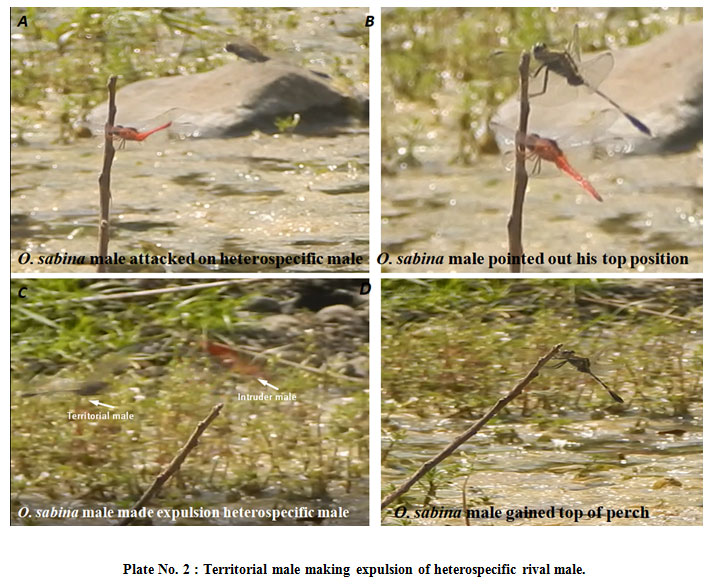 |
Plate 2: Territorial male making expulsion of heterospecific rival male |
Male territory
Male was setup his territory at the river near a dense vegetation around. He was pacing his seating locations on the perch nearby at three locations. He was seen to hover in and around his territory and defending it from rivals. He was seating on perch by dropping down his wings, my showed his alertness. He was setup his territory area circular about 6 meter in diameter. After one hour of hi pre reproductive activities he monopolize that area and waiting for receptive female. As he was become astir and ready for mating was seen by his activities. Grasping of Female : As soon as female entered territory of male, he suddenly face her with wing vibration the grasped female by using his abdominal appendices on her head behind her eyes, the grasping event was specifically marked with wings flapping sound like buzzing sound. The pair then flew towards perch in or around territory for matinFemales Acceptance and copulatory wheel formation: If female was willing for mating then female curls her abdomen under her body to collect the sperm from the male’s secondary genitalia that is at the situated on the sternites of segments 2-3 on his abdomen. Female locked her abdomen too forms a copulatory wheel ‘tandem’. This event was complied within 4-5 second.
Sperm Transfer
Male rested on a perch with female in copulatory wheel (Plate No. 3) position, and transfers his sperms from secondary genitalia to female genitalia (sperm-storage organs) and fertilization apparatus which were located between the eighth and ninth abdominal segments. The transfer of sperm was takes place in different time duration depending upon the disturbance or need of sperms quantity by females. We observed in case of O. sabina the time of copulations lasts from 0.5 min -56 min. in our record.
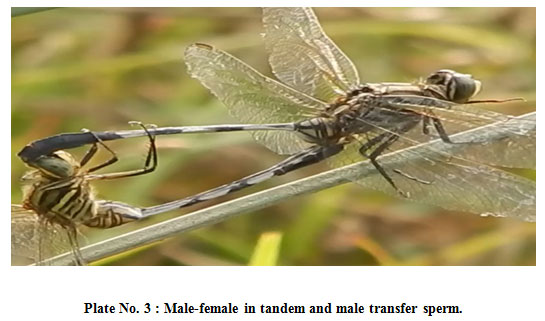 |
Plate 3: Male-female in tandem and male transfer sperm |
Breakage of copulatory wheel
When requirement of sperm was over or due to any disturbances male and female get separated from each other and female moved towards water body for oviposition.
Post mating events.-Mate Guarding
In O. sabina it was found that male generally guard mated female while ovipositing. The non-contact guarding was found in O. Sabina male hovered over ovipositing female. It hovered over female in different directions showed his alertness and protected her from intruder males (Plate No. 4 ). Intruder was seen to be conspecific or heterospeccific male was. Male was so aggressive while female was ovipositing. Male’s non-guarding decision also was observed in some cases.
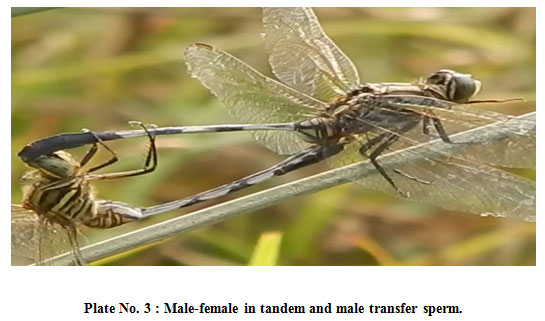 |
Plate 4: In O. sabina mate guarding behavior |
Oviposition
As soon as mating was over female moved towards water body for oviposition. Female spontaneously stated egg laying in the water body. The oviposition site was mostly the territory of mated male, or by chance related to disturbance it might be site beside to territory. We observed exophytic oviposition in this species. We found two way of exophytic oviposition in O. sabina i.e. i) laid eggs by washing its abdomen on water surface. ii) Laid eggs on submerged vegetation (Plate No. 5 ). Female flicked her ovipositor on surface where she desired to lay her eggs. She continuously laid her eggs in batches. She bulwarked herself from faze of other males and continuously She was frequently changing her locations of egg lying. She laid 41 to 150 clutches of eggs, its duration was from 1min – 3.5 min was noted. No underwater oviposition was observed.
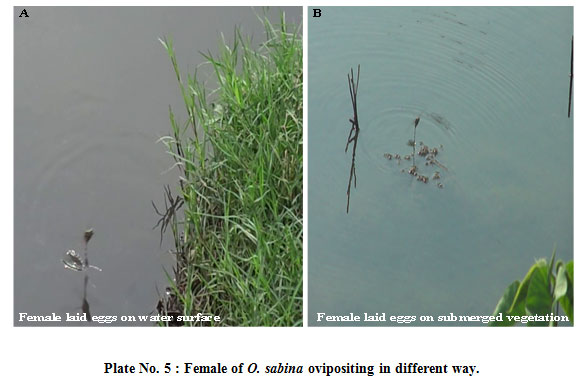 |
Plate 5: Female of O. sabina ovipositing in different way |
Case II- In this case female of Orthetrum sabina refuses mating and acted as death feigning was recorded.
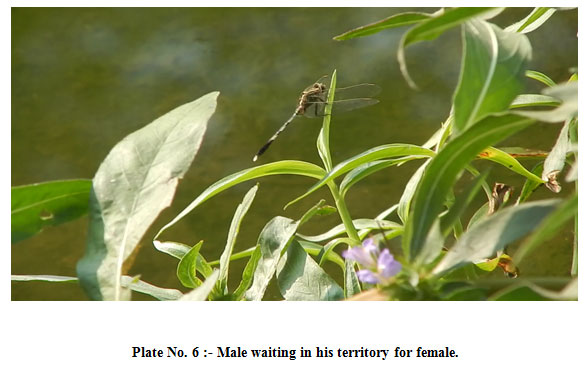 |
Plate 6: Male waiting in his territory for female |
Mating
Suddenly a conspecific female enters the territory. Male was eagerly waiting for this opportunity. He quickly fly in front of her, hover above grabbed her wings by his legs and seize her with his anal appendages behind her head. He then turns towards the perch in the territory. All this events get completed in just few seconds. He was seen to waiting for females turn to help in making tandem wheel by adjusting her abdomen near his the copulatory apparatus at the second and third segment. But his expectations get failed, as female refuse to do so.
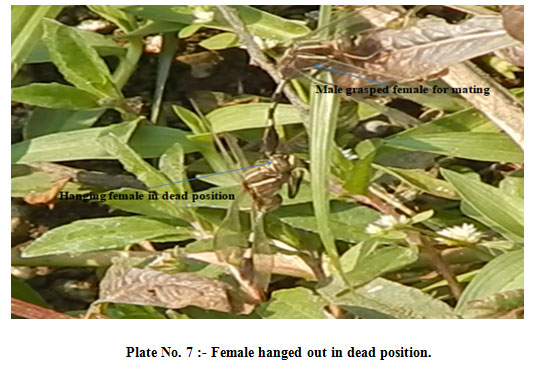 |
Plate 7: Female hanged out in dead position |
Mating refusal
In general after grasping female by her male she helps him for flying at perch and to make copulatory wheel the ‘tandem’ for copulation. On saturday, January 06, 2018, 1:25PM it was observed that the female he grabbed was evasive to make tandem and appeared to be resisting the males grasp by her wing vibration. She got hanged to males abdomen inactive for 7 min in dead position. Although she get injured her wings by vibrating she tries to escape and get freed from the grasp of importunate male without copulation. One failure of copulation added to account of that territorial male and female get freed from his grip and ran away.
 |
Plate 8: Female vibrates her wings to escape |
DISCUSSION
We also investigated that species studied were found territorial in behavior and defending it from intruders and rivals of conspecific and heterospecific males. Numerous similar studies (Lutz and Pittman, 1970; Baird and May, 2003; Worthen and Patrick, 2004).were conducted on communities of dragonflies that have found more intraspecific contests.
We found in our investigation that if female was willing for mating then female curls her abdomen under her body to collect the sperm from the male’s secondary genitalia that is at the situated on the sternites of segments 2-3 on his abdomen. Female locked her abdomen too forms a copulatory wheel ‘tandem’. This event was complied within 4-5 second. Similar willingness of female and coercion of male was also observed in a study by Waage (1984) he reported that in Odonates, the males have to persuade the female to mate in tandem and the female should be willing to engage her genitalia with the males.
We observed female Orthetrum sabina got hanged to males abdomen inactive for 7 min in dead position. Although she get injured her wings by vibrating she tries to escape and get freed from the grasp of importunate male without copulation showing her refusal towards mating. Similarly Waage, (1979, 1984), reported that unreceptive females react to courting males through the refusal display by spreading all four wings and raising the abdomen.
Conclusion
We conclude that in first studied case both male and female was matured and had willingness for mating so all proper reproductive events were followed by them. But in second case the female may be immature and not ready for mating, the male was not of her choice because he has poor territorial site, may be the eggs deposition by her would have already been accomplished for the day. Or female may have already carried sperm so she rejected that territory owner. She could still lay her eggs when the territorial male is absent, or can use another site.
REFERENCES
Anderson, W. J. (1994): Multiple mating in insects: a theoretical and empirical approach. MS Thesis, University of Oklahoma.
Bateman, A. J. (1948). Intra-sexual selection in Drosophila. Heredity 2, 349–368.
Bonduriansky, R. (2001). The evolution of male mate choice in insects: a synthesis of ideas and evidence. Biol Rev 76:305–339.
Burley, N. (1986). Sexual selection for aesthetic traits in species with biparental care. Am. Nat. 127, 415–445.
Corbet, P. S. (1962) A biology of Dragonflies Witherby, London.
Eberhard W. G. (1987). Use of horns in fights by the dimorophic males of Ageopsis nigricollis (Coleoptera, Scarabeidae, dynastinae). Journal of the Kansas Entomological Society 60: 504– 509.
Emlen, S. T. & Oring, L. W. (1977): Ecology, sexual selection, and the evolution of mating systems. Science 197: 215–223.
Fincke O. M. (1994a): Female dimorphism in damselflies: failure to reject the null hypothesis. Animal Behaviour 47:1249–1266.
Fincke, O. M. (1986a): Underwater oviposition in a damselfly (Odonata: Coenagrionidae) favors male vigilance, and multiple mating by females. Behavioral Ecology and Sociobiology 18: 405–412.
Fincke, O. M. (1997): Conflict resolution in the Odonata: Implications for understanding female mating patterns and female choice. Biol. J. Linn. Soc. 60: 201-220.
Forbes MRL & Teather RL. (1994): Variation in attraction of male Enallaama ebrium (Hagen) to two female morphs (Zygoptera: Coenagrionidae). Odonatologica 23: 103–114.
Forbes MRL. (1991): Female morphs of the damselfly Enallagma boreale Selys (Odonata: Coenagrionidae): a benefit for androchromatypes. Canadian Journal of Zoology 69: 1969–1970.
Gorb, S. (1992): An experimental study of the refusal display in the damselfly Platycnemis pennipes (Pall.) (Zygoptera: Platycnemididae). Odonatologica 21: 299–307.
Hadley, D (2019) How dragon flies mate Thought. Co www.thought.com
Hadrys, H. et al., (1993): Determination of paternity in dragonflies by random amplified polymorphic DNA fingerprinting. Molecular Ecology 2: 79–88
Hoefler, C. D. (2008). The costs of male courtship and potential benefits of male choice for large mates in Phidippus clarus (Aranea, Salticidae). J Arachnol 36:210–212.
Kaiser, H. (1985): Availability of receptive females at the mating place and mating chances of males in the dragonfly Aeschna cyanea. Behavioral Ecology and Sociobiology 18: 1–7.
Kirkpatrick, M. (1982): Sexual selection and the evolution of female choice. Evolution 36: 1–12.
Lima, S. L. & Dill, L. M. (1990): Behavioral decisions made under the risk of predation: a review and prospectus. Can. J. Zool. 68, 619—640.
Magnhagen, C. (1991): Predation risk as a cost of reproduction. Trends Ecol. Evol. 6, 183—186.
Parker,G. A. (1979): Sexual selection and sexual conflict In M.S. BLUM and N.A . BLUM (eds) Sexual selection and reproductive competition in insects. Academic press.
Pomiankowski, A. (1988). The evolution of female mate preferences for male genetic quality. Oxford Surveys in Evolutionary Biology 6: 136–184.
Price, T.; Schulter, D. & Heckman, N. E. (1993): Sexual selection when the female directly benefits. Biological Journal of the Linnean Society 48: 187–211.
Rausher, M. D. (1979): Larval habitat suitability and oviposition preference in three related butterflies. Ecology 60, 503—511.
Robertson H. M. (1985): Female dimorphism and mating behaviour in a damselfly, Ischnura ramburi: females mimicking males. Animal Behaviour 33: 805–809.
Roff, D. A. (1992). The evolution of life histories: theory and analysis. New York: Chapman & Hall.
Thornhill, R. and Alcock, J. (1983). The Evolution of Insect Mating Systems. Boston: Harvard University Press.
Trivers R. L. (1972). Parental investment and sexual selection. In: Campbell B (ed) Sexual selection and the descent of man, 1871–1971. Aldine, Chicago, pp 136–179.
Waage J. K., (1973) : Reproductive behaviour and its relation to territoriality in Calopteryx maculata (Beauvois). Behaviour, 47: 240-256
Waage, J. K. (1984a): Sperm competition and the evolution of odonate mating systems. In: Smith RL, ed. Sperm Competition and the Evolution of Animal Mating Systems. New York: Academic Press, 251–290.
Waage, J. K. (1984). Female and male interactions during courtship in Calopteryx maculata and Calopteryx dimidiata (Odonata: Calopterygidae): Influence of oviposition behavior. Anim. Behav. 32, 400–404.
Waage J. Κ., (1988) : Reproductive behavior of the damselfly Calopteryx dimidiata Burmeister (Zygoptera: Calopterygidae). Odonatologica, 17: 365-378.
Wedell, N. (1996). Mate quality affects reproductive effort in a paternally investing species. Am Nat 148:1075–1088.


